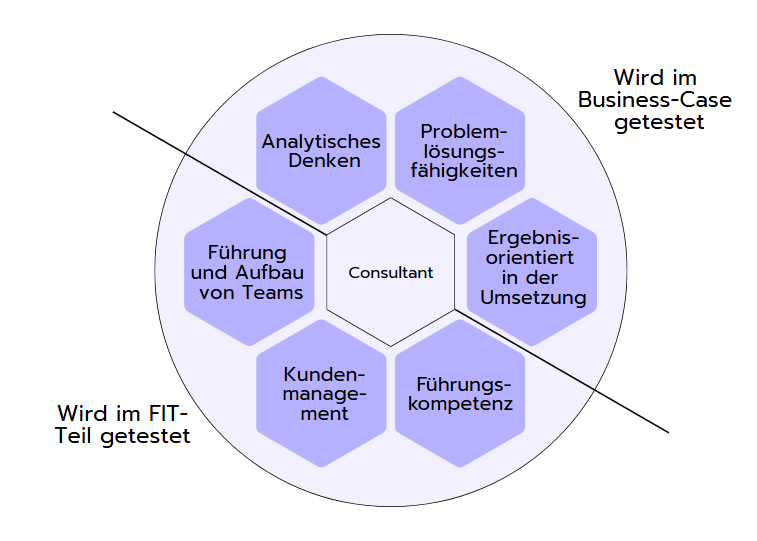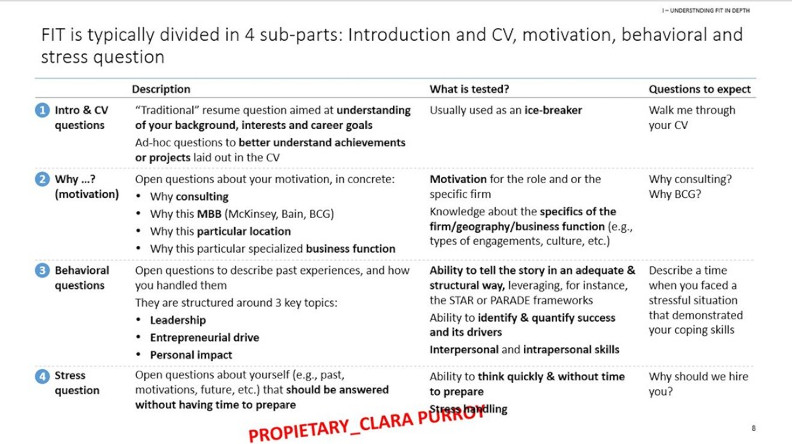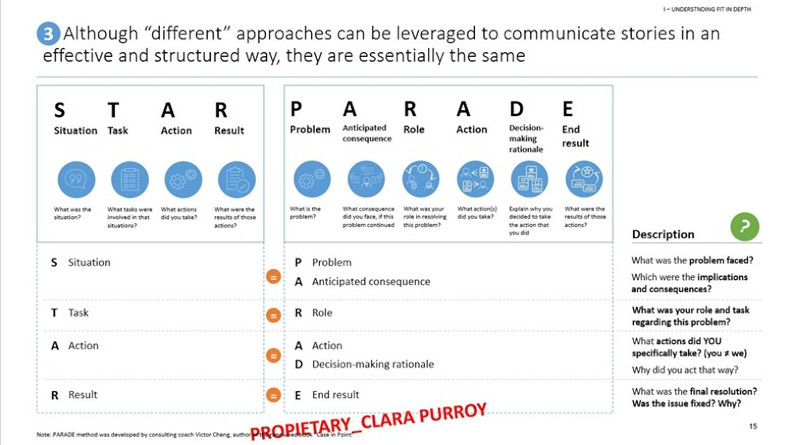Top 7 Behavioral Questions im Bereich Entrepreneurial Drive
Entrepreneurial Drive ist der zweite Aspekt im Behavioral Interview, den wir uns genauer anschauen. Typische Fragen, die auf dieses Thema abzielen, sind:
- Beschreibe eine Situation, in der du einen neuen Ansatz wählen oder um die Ecke denken musstest.
- Beschreibe eine Situation, in der du eine wichtige geschäftliche Entscheidung ohne Rücksprache mit deinem:r Vorgesetzten getroffen hast.
- Beschreibe eine Initiative, die du selbst gestartet hast.
- Beschreibe eine Entscheidung, die du unter großer Unsicherheit oder ohne die nötigen Daten treffen musstest.
- Beschreibe eine Situation, in der du dir tiefere Fachkenntnisse aneignen musstest, um deine Arbeit gut oder besser zu machen.
- Beschreibe eine Situation, in der du ein kalkuliertes Risiko eingegangen bist.
- Beschreibe eine Situation, in der du eine einfache Lösung für ein komplexes Problem gefunden hast.
Wie du auf Fragen zum Entrepreneurial Drive im Behavioral Interview antworten solltest
Im folgenden Abschnitt schauen wir uns eine Frage etwas genauer an, mit der dein unternehmerischer Drive getestet wird. Dabei beginnen wir wieder mit der Frage selbst und gehen dann Schritt für Schritt durch, wie eine gute Antwort aussehen kann. Dabei solltest du erneut mit der Ausgangssituation und dem Problem starten, über die Rollenverteilung und die Maßnahmen sprechen und am Ende zum Ergebnis und dem, was du erreicht hast, überleiten.
Beispielfrage – Entrepreneurial Drive:
„Beschreibe eine Situation, in der du die Initiative ergriffen hast, um ein Problem zu lösen, das eigentlich nicht in deinen Aufgabenbereich fiel” (z.B. im Zusammenhang mit einem neuen Projekt oder einem neuen Lösungsansatz für ein bekanntes Problem).
Problem und Situation:
Ich war erst seit etwa zwei Monaten bei Amazon. Auch mein Team war neu und existierte erst seit September desselben Jahres. Wir bestanden aus drei Neueinsteiger:innen, einem etwas erfahreneren Kollegen und unserem Manager.
Die Woche rund um Black Friday ist für Amazon geschäftskritisch: Bis zu 25 % des Jahresumsatzes werden in dieser Woche erzielt und für unser Team war es das erste Jahr, in dem wir als Business Unit überhaupt existierten.
Ende Oktober kündigte der einzige erfahrene Kollege im Team an, dass er das Unternehmen Mitte November verlassen würde – also unmittelbar vor dem Event. Er war für die Planung und Umsetzung der Black-Friday-Kampagne verantwortlich gewesen.
Aufgabe (Rolle):
Offiziell war ich als „Individual Contributor“ mit klar abgegrenzten KPIs eingestellt. Außerdem befand ich mich wie alle im Team noch in der sechsmonatigen Einarbeitungsphase, in der keine zusätzlichen Projekte übernommen werden mussten.
Formal war es also nicht meine Aufgabe, das Problem zu lösen, aber faktisch betraf es das ganze Team. Da ich unter den drei Neueinsteiger:innen der Erfahrendste war, habe ich mich entschieden, dem Team zu helfen und Verantwortung zu übernehmen.
Aktion:
Ich entschied mich, die Rolle der zentralen Ansprechperson (POC) für die Black-Friday-Kampagne zu übernehmen, obwohl ich anfangs nicht einmal wusste, was das konkret bedeutete und welche Maßnahmen erforderlich waren.
Deshalb recherchierte ich im ersten Schritt die genaue Zielsetzung und gängige Methoden, indem ich mich mit Teams in anderen Regionen – sowohl innerhalb Europas als auch in meinem lokalen B2C-Bereich – austauschte. Durch kontinuierliches Shadowing und gezielte Fragen konnte ich die Vorbereitungsprozesse dieser Teams nachvollziehen und auf unser Setup übertragen, auch wenn wir bereits deutlich hinter dem Zeitplan lagen.
Ein zentrales Problem: Uns fehlte ein Dashboard, mit dem wir die Performance unserer Angebote in Echtzeit hätten überwachen können. Ohne ein solches Tool wäre eine gezielte Steuerung oder Troubleshooting während der Black-Friday-Woche nahezu unmöglich gewesen.
Da wir weder BI-Ressourcen (die man wochenlang im Voraus buchen muss) noch SQL-Kenntnisse zur Verfügung hatten, entwickelte ich eine pragmatische 80/20-Lösung: Ein manuelles Excel-Dashboard, das auf täglichen CRM-Daten beruhte. Die Daten wurden am Ende jedes Tages manuell heruntergeladen und ins Modell eingepflegt. Das kostete eine Stunde täglichen Aufwand, den ich gemeinsam mit zwei Kolleg:innen übernahm. Nicht ideal, aber ein MVP, das funktionierte.
Die einzige Schwachstelle blieb der manuelle Aufwand, da man die Daten eigentlich mittels SQL query automatisiert aus dem Data Lake hätte ziehen müssen. Da mir dafür das technische Wissen fehlte, wählte ich die einzige Herangehensweise, die ich umsetzen konnte: manuelles Herunterladen von täglichen EOD Reports für jeden beteiligten Account und Übertragen der Daten in das Dashboard.
Ergebnis & Impact:
Die Lösung hatte zwei zentrale Auswirkungen:
- Das Dashboard ermöglichte uns, Probleme frühzeitig zu erkennen und direkt gegenzusteuern. Über 200 ASINs von 20 verschiedenen Accounts konnten so tagesaktuell überwacht und bei Bedarf angepasst werden. Dadurch konnten wir nicht nur unsere Umsatz- und Wachstumsziele erreichen, sondern sie sogar um 10 % bzw. 15 % übertreffen.
- Außerdem konnten wir die Daten für eine fundierte Nachbereitung und Analyse nutzen, was ohne das Tool nicht möglich gewesen wäre.
Persönlich habe ich gelernt:
Auch wenn man nicht das perfekte Know-how oder die optimale technische Lösung zur Hand hat, kann man immer ein MVP bauen, das vielleicht nicht perfekt ist, aber die wichtigsten Anforderungen abdeckt und es Schritt für Schritt weiterentwickeln.
Die 14 wichtigsten Behavioral-Fragen zum Bereich Personal Impact
Der letzte Aspekt, in den wir tiefer einsteigen, ist Personal Impact. Hier geht es darum, wie gut du mit Stakeholdern umgehen kannst – insbesondere in Konfliktsituationen und bei Meinungsverschiedenheiten.
Hier sind die wichtigsten Behavioral-Fragen zu diesem Thema:
- Beschreibe eine Situation, in der du eine:n schwierige:n Stakeholder:in überzeugen musstest.
- Wie würdest du als Consultant in unserem Team mit einem unkooperativen Kunden umgehen, um an die nötigen Daten zu kommen?
- Wie gehst du mit Konflikten um? Beschreibe ein Beispiel.
- Beschreibe eine aktuelle Krise, die du bewältigt hast.
- Beschreibe eine Situation, in der du eine wichtige Person oder Gruppe beeinflusst oder überzeugt hast.
- Erzähle von einer beruflichen Situation, in der du deine Kolleg:innen positiv beeinflusst hast.
- Beschreibe eine Situation, die zeigt, dass du gut im Team arbeitest.
- Beschreibe eine Meinungsverschiedenheit mit deinem:r Vorgesetzten. Wer hat wen überzeugt – und warum?
- Beschreibe eine Situation, in der du eine:n Stakeholder:in von deinem Standpunkt überzeugen musstest.
- Beschreibe eine Situation, in der du eine Veränderung oder Initiative durchsetzen wolltest, die bei Stakeholdern zunächst auf Ablehnung stieß.
- Beschreibe eine Situation, in der du einem Teammitglied bei der beruflichen Weiterentwicklung geholfen hast.
- Beschreibe eine Situation, in der du für einen Kunden oder eine vergleichbare Situation außergewöhnlich viel geleistet hast.
- Gib ein Beispiel für kritisches Feedback, das du erhalten hast.
- Beschreibe eine Situation, in der du eine Gruppenentscheidung mitgetragen hast, obwohl du anderer Meinung warst.
Wie du auf Fragen zum Personal Impact im Behavioral Interview antwortest
In diesem letzten Deep Dive schauen wir uns eine typische Frage an, die auf deinen persönlichen Impact abzielt. Anschließend bekommst du ein Beispiel für eine strukturierte Antwort, die wie immer entlang der vier Schlüsselelemente aufgebaut ist: Problem & Situation, deine Rolle, deine Maßnahmen und das Ergebnis bzw. der Impact.
Im Folgenden sehen wir uns diese Beispiel-Frage näher an:
Beispielfrage – Personal Impact:
„Beschreibe eine Situation, in der du eine:n relevante:n Stakeholder (z. B. Manager:in oder Kund:in) von einer anderen Vorgehensweise überzeugen musstest.“
Situation:
Ich war als Business Analyst bei McKinsey Teil eines fünfköpfigen Teams, das für einen der führenden Immobilienentwickler in Frankreich arbeitete.
Das Geschäftsmodell des Kunden basierte stark auf Standardisierung: Es gab nur wenige „Haus-Prototypen“, die in standardisierter Bauweise errichtet wurden. Synergien standen im Fokus.
Vor diesem Hintergrund war der Design-to-Value-Workstream ein zentraler Bestandteil unseres Projekts. Ziel war es herauszufinden, welche Wohnmerkmale für Endkund:innen am wichtigsten sind (z. B.: Ist ein hochwertiger Naturholzboden wichtiger oder ein gemeinschaftlicher Swimming Pool?).
Aufgabe (Rolle):
Als Leiter des Design-to-Value-Workstreams war ich verantwortlich für (1) die Durchführung der Marktanalyse und (2) die quantitative Auswertung der Ergebnisse.
Für den Erfolg war es entscheidend, die wichtigsten Stakeholder mit ins Boot zu holen, insbesondere zwei Schlüsselpersonen: den Director of Product (zuständig für Produktspezifikationen) und den Director of Operations (zuständig für Kostenkalkulation). Die beiden lagen jedoch im Clinch miteinander, und es herrschte ein regelrechter Abteilungskrieg.
Aktion:
Zunächst war der CEO mit unserem geplanten Ansatz, eine klassische Kundenbefragung durchzuführen, einverstanden. Doch zu Beginn des Projekts stellten wir fest, dass das Produktteam solche Umfragen bereits in der Vergangenheit durchgeführt hatte. Diese hatten zu den bestehenden Prototypen geführt, die nun aber als zu teuer und nicht kundenzentriert galten. Die internen Spannungen zwischen Produkt- und Operations-Team verschärften sich dadurch weiter.
Mir wurde klar: Wenn wir an unserem ursprünglichen Ansatz festhielten, würden wir kaum neue Erkenntnisse gewinnen und gleichzeitig keine Lösung für den internen Konflikt liefern. Die Abteilungsleiter waren nicht überzeugt von unserem Vorschlag und sahen keinen Mehrwert.
Ich recherchierte daraufhin intensiv nach alternativen und präziseren Methoden und sprach mit Marketing-Expert:innen, insbesondere aus Branchen mit hohen Anforderungen an Marktforschung wie der Konsumgüter- und Automobilindustrie.
Auf Grundlage dieser Gespräche habe ich einen neuen Ansatz empfohlen: die Conjoint-Analyse. Diese Methode ist zwar komplexer und aufwendiger als klassische Umfragen, liefert dafür aber deutlich präzisere Ergebnisse. Mithilfe eines speziellen Fragebogens lässt sich ermitteln, welchen Nutzwert einzelne Gebäudemerkmale für Kund:innen haben, also wie wichtig bestimmte Eigenschaften wirklich sind. Bezieht man zusätzlich den finanziellen Nutzwert mit ein, lässt sich sogar die Zahlungsbereitschaft für jedes Feature berechnen. Für das Operations-Team ist das ein messbarer Wert, der besonders viel Nutzen stiftet und entsprechend hoch geschätzt wird.
Gemeinsam mit meinem Team habe ich einen Workshop mit dem Top-Management auf C-Level-Ebene und den beiden kritischsten Stakeholdern aus den Bereichen Product und Operations organisiert. Ich war dabei hauptverantwortlich für die Präsentation. Ziel des Workshops war es, die neue datenbasierte Methodik vorzustellen und aufzuzeigen, wie sich Produktmerkmale und Kostenkalkulation in diesem Ansatz miteinander verbinden lassen.
Ergebnis & Impact:
Auf Kundenseite war das Projekt ein voller Erfolg:
- Wir konnten deutlich detailliertere Insights generieren – ein Punkt, bei dem der Kunde zunächst skeptisch gewesen war.
- Die Zahlungsbereitschaft für jedes einzelne Feature wurde berechnet – ein messbarer und objektiver Maßstab für die Bewertung.
- Daraus entstand ein datenbasiertes Entscheidungsmodell, das Zahlungswilligkeit und Kostenkalkulation in Relation setzte – eine fundierte Grundlage für zukünftige Entscheidungen über Gebäudemerkmale.
Persönlich war es eine prägende Erfahrung im Stakeholder-Management, nicht nur aufgrund der technisch anspruchsvollen Methodik, sondern auch weil ich mit dieser Vorgehensweise zwei Konfliktparteien zusammenbringen konnte: Ich habe gelernt, wie man selbst skeptische Stakeholder durch fundierte Datenanalysen und gezielte Fachgespräche mit Expert:innen überzeugt.
Wie du dich auf ein Behavioral Interview vorbereitest
Wenn du es bis hierher im Artikel geschafft hast, dann Glückwunsch! Du hast bereits viele wertvolle Einblicke gesammelt, wie du ein Behavioral Interview erfolgreich meistern kannst.
Für noch mehr Tipps und Hintergrundwissen empfehlen wir dir unseren kostenlosen BootCamp-Artikel zum Personal Fit Interview.
Falls danach noch Fragen offen sind, kannst du diese jederzeit in unserem Consulting Q&A stellen. Unsere erfahrenen Coaches teilen gerne ihre persönlichen Erfahrungen mit dir und haben jede Menge nützlicher Hinweise parat!
Dein nächster Schritt:
Setze dein neu erlerntes Wissen in die Praxis um!
Auf PrepLounge kannst du Interviews mit anderen Case-Partner:innen üben! Sie testen nicht nur deine Fähigkeiten beim Lösen von Cases, sondern geben dir auch ehrliches Feedback zu deinen Antworten auf Behavioral-Fragen.
Schlage dafür einfach eine Practice Session auf unserem Meeting-Board vor. So bekommst du hilfreiches Feedback zu deinen Stories. Zusätzlich kannst du unseren interaktiven Stressfragen-Modus nutzen: Dort findest du über 110 mögliche Fragen, die im Personal-Fit-Teil deines Interviews auf dich zukommen könnten.
Zum Schluss möchten wir dir noch Claras Integrated FIT Guide ans Herz legen.
Der Guide bietet eine vollständige Vorbereitung auf alle drei Interview-Runden bei MBB und andere Consulting Interview – inklusive Review von Schlüsselkonzepten und praxisnahen Techniken. Du arbeitest deine Stories anhand von über 50 realen Fragen aus und nutzt spezielle Frameworks und Worksheets, die dich Schritt für Schritt begleiten. Außerdem enthält der Guide über 20 Beispiele von echten Interviewkandidaten.
Zum Autor









